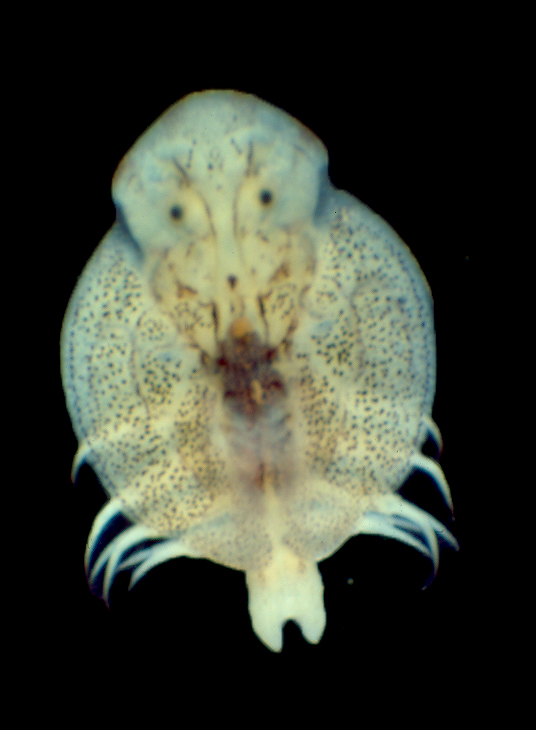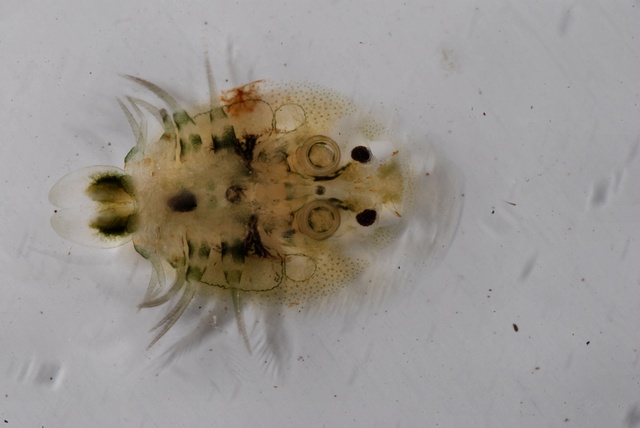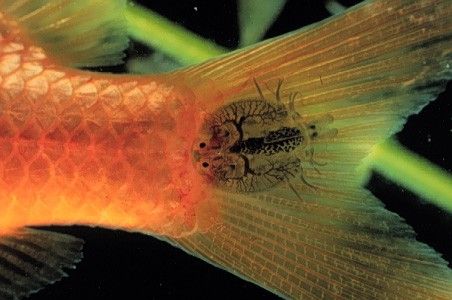Phylum Arthropoda
Subphylum Crustacea
Class Maxillopoda
Subclass Branchiura
Order Arguloidea
Common names: arguloids, fish lice
Overview
Arguloidea, or fish lice, are flattened, ectoparasitic, aquatic crustaceans.They are the only extant order in the subclass Branchiura, which also contains the extinct Cyclida. They are characterised by a large oval-shaped anterior shield or carapace that is laterally expanded, almost covering the entire body, including their prominent compound eyes. The carapace possesses a posterior notch where the abdomen protrudes from. The anterior appendages (mouthparts) are modified for their parasitic lifestyle into a pair of suction disks with central hooks for either piercing or attachment to their host. The trunk bears four pairs of short, simple appendages, with the last three pairs having feathery margins. Arguloids are small, up to approximately 10 mm in length.
Distribution and diversity
Arguloida are widely distributed around the world and inhabit both freshwater and marine environments where around 200 species have been described. The order contains a single family (Argulidae) comprised of four genera (Argulus, Chonopeltis, Dipteropeltis and Dolops). In Australia, arguloids (Argulus and Dolops) are known from aquarium fish, the golden carp, from a native trout gudgeon in eastern Australia, a galaxiid in the now flooded Lake Pedder, Tasmania and from an unknown host in Western Australia.
Life cycle
Arguloids leave their hosts for up to three weeks in order to mate and lay eggs. Mating is reported to involve the transfer of a spermatophore/s to the female. Females deposit eggs on plants or other suitable surfaces and egg are fertilised as they emerge. They can lay several batches of eggs during their adult lives and will find a new host after depositing each batch. Eggs take three to four weeks to hatch and newly hatched larvae quickly search for a suitable host on which to attach. Seven to nine larval stages are reported, with first stage larvae appearing quite different from the adults. Later larval stages become successively more adult-like in appearance.
Feeding
Arguloids are typically found on the external surfaces (operculum) and in the gill chambers of fish. However, they are capable of leaving their hosts for prolonged periods to find mates, lay eggs and search for new hosts. Attachment to the host is by various anterior appendages modified into suckers and/or hooks. Material ingested is variable with some species piercing the skin and feeding on blood, while others feed on mucous and epidermal cells and scales. Once engorged, some arguloids can survive without feeding for several weeks.
Ecology
Arguloids occur in marine, brackish and freshwater habitats. Almost all are ectoparasites on fish, with a few species living on amphibians. Unlike many parasites, arguloids are not very host specific. Most are capable of surviving away from the host independently, but rely on a host for food. When they locate a new host they move towards the head, and attach behind the operculum or a fin. Attaching in these slightly protected areas reduces the likelihood they will be brushed or washed off of the host. Fish lice can be significant pests in aquaculture where their feeding spreads disease and weakens or kills fish. They usually occur in freshwater farms, but occasionally infest marine stocks. Domestic aquariums may also be affected by infestations of fish lice.

Argulus sp., a parasite on an eel collected from a dam near Grafton (NSW)
Image credit: � Brett Ingram
used with permission









